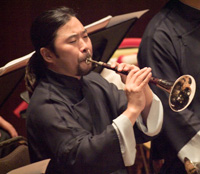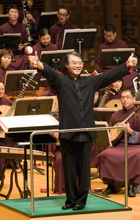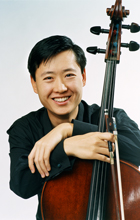Watch a Video
Excerpt from Cheng Dazhao's Yellow River Capriccio.
Courtesy of the Hong Kong Chinese Orchestra.
Related Essays
An Introduction to Chinese Orchestras

China has a long history of musical ensembles; on rare imperial occasions, players could number in the hundreds. These, however, usually involved multiple players on a single part. The modern incarnation of Chinese orchestras—traditional instruments in symphonic groupings—dates back only to the 1950s, after the People’s Republic had called on China’s musical community to revolutionize the art for the Chinese people.
Much criticism in China had been leveled at Western music, but this nearly always concerned the repertory. The instruments themselves—primarily the violin and piano—were held up as models of modern design. It was within this environment—with makers being urged to adapt traditional instruments to comparable standards in pitch, flexibility, and timbre—that the instruments themselves came to be grouped in a Western manner.
Among the winds, the dizi (bamboo flutes) also covered the pitch range of Western alto and bass flutes. The sheng, a mouth organ (and ancient predecessor to both the pipe organ and the accordion), had been made chromatic, allowing for much greater harmonic function. The suona, essentially a double-reed pipe with a large bell, became the piercing equivalent of trumpets (and, in new larger, lower-pitched models, the trombone).
Bowed strings consisted (from high to low) of the gaohu, erhu, and zhonghu, which generally became orchestrated in split sections like Western violins and violas. Top orchestras often use the gehu and diyingehu, although due to their rarity most Chinese orchestras use their standard Western equivalents, the cello and double bass.
A section of the Chinese orchestra not often found in its Western model is plucked-strings, whose instruments come in various shapes, from the pear-like pipa to the round ruan. The dulcimer-like yangqin is generally placed in the middle of the orchestra, its function similar to the harpsichord in a Baroque ensemble.
Chinese percussion—the oldest of the instrument groups—divides into luo (gongs), gu (skin drums), bo (cymbals), bianzhong (literally, “grouped bells”), and various wooden instruments from bamboo clappers to temple blocks. Of all the groups, percussion arguably made the easiest transition, as several instruments such as gongs and temple blocks had already become standard instruments in the West.
Although the early pieces for these ensembles consisted mostly of folk-song arrangements, the Chinese orchestra now has an enormous repertory of new works. Thanks to aggressive commissioning efforts by organizations in Hong Kong, Taiwan, Singapore, and Macao, nearly every living Chinese composer has contributed to the repertory.
Learn more about the instruments. ![]()
Focus On: Guo Wenjing
During Guo Wenjing’s first significant trip abroad—a belated six-month New York residency in 1996–1997 under the auspices of the Asian Cultural Council—the Sichuan-born composer finished a piece for cello and ensemble. He hated it. In his program note, he apologized by saying the table in his apartment was unsteady. “One should never compose on a shaky table,” he maintains.
Those who know Guo’s life story could hardly miss the metaphor. Much of the composer’s allure in Europe and the US has been due to the fact that—unlike fellow Central Conservatory students Tan Dun, Chen Yi and Zhou Long—he never left China, resulting in a palpable rootedness in the cultural soil. Rather than inertia, this was a conscious decision: Supporting himself in Europe or America would’ve taken time away from his art, he claims. So too would it have distanced him from the traditional instrumentalists and singers who have been his most constant source of inspiration.
China’s turbulent culture today is nearly as potent an influence as traditions of the past. “As a Chinese composer living in China, it is my job to express my feelings about what is happening here right now,” he says. “Some of my classmates have been very successful in America. They’ve even become American citizens. But from my point of view, they’ll never become American … Even if I’m successful in America, if American people love my music, so what? In one simple sentence, I don’t feel that could be my final resting place.”
In His Own Words
On being a “Chinese” composer:
“I don’t make music for the world or for China. I make what I like. That music is greatly influenced by my past and my cultural background. My work is not based on any given theory. And I don’t have a motto. I follow my heart …”
“I don’t know what a Chinese composer should be. No one can regulate what Chinese music should be. Any pre-design of what is or is not Chinese will be wrong. My purpose is to create, and I feel that there’s ground beneath my feet. Even if the Chinese people don’t accept me, my compositions are still part of Chinese culture—or at least a part of contemporary Chinese life—simply because I live in China.”
On the Cultural Revolution:
“During the Cultural Revolution, fighting swept through Chongqing. There were tanks in the streets. They shot guns and cannons from ships on the Yangzi. It was dangerous, but I was a child. I enjoyed watching the fighting. Then my parents bought me a violin so I would stay indoors. That was my first introduction to music.”
Program Notes
LAW WING-FAI (b. 1949)
Flowing Phantasm
About the Composer
Born in China in 1949, Law Wing-fai was educated in Taiwan and at the University of California before settling in Hong Kong in 1980. Within a year, he won the Asian Composer League’s Yoshiro Irino Memorial Award for young composers. Since that time, Law has amassed a diversified repertoire of concert and commercial music, from orchestral and chamber compositions to pop songs and scores for more than 20 films. He was on the faculty of the Hong Kong Academy for Performing Arts as head of the composition department until 1998, when he became the academy’s Composer-in-Residence.
About the Work
Floating Phantasm was commissioned as part of Cadenzas of Hong Kong, a two-year collaboration between the Hong Kong Composers Guild and the HKCO in honor of the orchestra’s 30th anniversary season. Requirements for the project were that each piece be intended as a short concert opener, and in some way reflect the culture of the region. The piece was inspired by the composer’s childhood memories of the Star Ferry—the passenger service across Victoria Harbor between Hong Kong Island and the Kowloon peninsula—and the neon lights of the city reflected on the surface of the water. Through this work, he summons nostalgic memories of the old Queen’s Pier, which was closed in 2007 and demolished in early 2008 despite a fierce preservation campaign.
A Closer Listen
In this highly atmospheric piece, the composer seeks to represent in music the temporal-spatial effect of ink painting. Through various instrumental combinations, he attempts “the musical effect of controlled diversity in flying rhythmic patterns.” The work begins with impulsive sonic strokes from various instrumental sections, often layered in different rhythmic patterns to mimic the effect of waves. Altercations between sections gather in intensity, pushing toward a climax, with each successive stroke giving the impression of a brush that never quite leaves the canvas.
GUO WENJING (b. 1956)
Three Melodies of West Yunnan
About the Composer
A member of the illustrious “Class of 1978”—the first group of composers to enter conservatory after the Cultural Revolution—Guo Wenjing has become the most internationally celebrated composer still living in China and honored at home as one of the country’s “Top 100 Living Artists.” He has written extensively for both Chinese and Western instruments, often in various combinations, and he has been particularly noted for fusing a modernistic musical language with a strong flavor of his native Sichuan. The former head of composition at Beijing’s Central Conservatory of Music, Guo remains on the faculty and maintains an active schedule of commissions for musical organizations both at home and abroad. He is published by Casa Ricordi.
About the Work
Three Melodies of West Yunnan was written for the HKCO in two installments: The first two movements were written in 1993 and premiered in March 1994; the third was premiered by the HKCO in February 2009. The first two movements describe specific ethnicities in Yunnan Province: the Va, who live in the mountains, and the Jino, the original inhabitants of the region who are known for cultivating tea. Elements of both pantheistic cultures are illustrated in the music. The third movement is not intended to illustrate any particular tribe, but is rather a trio of scenes from the daily lives of local people, emphasizing their robust character. “This piece was written over 15 years,” the composer writes. “I have to thank Mr. Yan Huichang, Artistic Director of the HKCO, for his patience, tolerance and persistence.”
A Closer Listen
Percussion has been a hallmark of Guo’s output over the years, and this piece is no different. The first movement, A Va Mountain, opens with brash percussion, proceeding deliberately with percussive sounds even on the plucked string instruments. The percussion section itself calls for seven players on instruments ranging from chimes to coconut shells. Jino Dance is comparably brisker, though initially of equally somber character. A folk ballad appears in the middle section before the music returns to its original pace. The third movement divides into three distinct sections: Sacrifice, Torches, and Potent Liquors.
ZHAO JIPING (b. 1945)
Zhuang Zhou's Dream
About the Conductor
The most senior composer on tonight’s program, Zhao Jiping was born in Pingling in Gansu province. He received his early education from the Xian Conservatory of Music and, in 1978, was admitted as a graduate student to the Central Conservatory. He has long been one of China’s most prominent composers, known both at home and abroad primarily for scoring nearly every Chinese film to gain international recognition in the 1990s, including Raise the Red Lantern and Farewell My Concubine. One of the first composers to combine Western and Chinese instruments, he has received awards at both the Cannes and Berlin film festivals, and was himself the subject of Allan Miller’s documentary film Music for the Movies: Zhao Jiping. He is currently Director of the Shaanxi Province Opera and Dance Theater.
About the Work
Having already composed the chamber piece Moon Over Guan Mountain for Yo-Yo Ma and the Silk Road Ensemble, Zhao was commissioned by the HKCO to write a piece for the orchestra with Ma as soloist. Zhuang Zhou’s Dream was finished in 2006 and premiered at the Hong Kong Cultural Centre in autumn 2008. The composer takes his inspiration from the most famous saying of the Taoist philosopher from 4 BCE: Awakened from a dream of being a butterfly, Zhuang Zhou questioned, “Am I a man who dreamed I was a butterfly, or a butterfly now dreaming I am a man?”
A Closer Listen
A study in anti-virtuosity, Zhuang Zhou’s Dream consciously shuns overt displays of performance technique, as well as avoiding the usual antagonistic relationship between soloist and larger ensemble endemic to the concerto genre. In its place is a characteristically Taoist approach of letting soloist and orchestra pursue their own separate—yet related—paths, the music flowing freely in a dreamlike manner.
CHENG DAZHAO (b. 1949)
The Yellow River Capriccio
About the Composer
Cheng Dazhao was born in Xian, the capital of Shaanxi province and the seat of ancient Chinese history. A prolific composer, he has written several pieces for Western orchestra, more than 40 works for Chinese orchestra, and musical scores for more than 30 feature films and 40 commercial television dramas. Cheng is a prominent composer with the Zhujiang Film Studio and a director of the Chinese Musicians Association. He currently lives in Beijing and is a Visiting Professor of the Xian Conservatory of Music.
About the Work
The composer writes: “Do you know how many meanders there are in the Yellow River’s course? For thousands of years, the Yellow River has shaped the character of the people living along its banks. The Yellow River has many guises—turbulent when its waves surge, desolate when it reminds us that ‘a still river runs deep,’ unexpected with its numerous zigzag course, and joyous as it trips along the way … The changing scenes and emotions are depicted in this work, and as the music flows, it presents the many facets of life along the river, as well as their vision of a better tomorrow.”
A Closer Listen
Percussion, which has hardly been a subtle part of the HKCO’s profile, once again takes a prominent role in the boisterous rhapsody—not only on stage, but also in the audience. Small Chinese hand drums will be distributed throughout the Hall prior to the concert so that audience members can participate in performing the climatic portions of the piece.
—Ken Smith
© 2009 The Carnegie Hall Corporation




 This performance is sponsored by the Hong Kong Economic & Trade Office, New York.
This performance is sponsored by the Hong Kong Economic & Trade Office, New York.